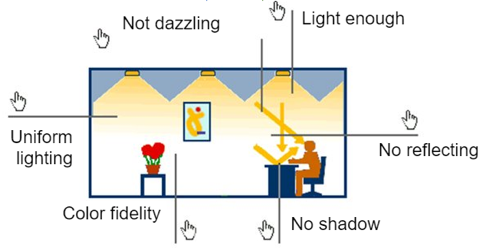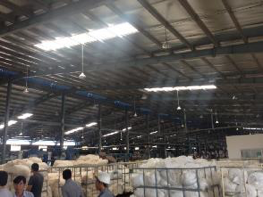WHAT SHOULD ENTERPRISES DO TO HAVE EFFECTIVE LIGHTING SYSTEM?
In modern life, lighting plays an important and indispensable role for people and enterprises. Building an effective lighting system is one of the necessary and urgent tasks for enterprises in the present time.
An efficient lighting system must include visual comfort and minimizing energy consumption for the system. This means that the system can save electricity and maintain user satisfaction, gain economy, protect the environment, suitable for space and safe for users.

Poor lighting in the workplace leads to eye strain, tiredness, and accidents. While excessive lighting causes safety and health issues like headaches and stress. Both cases can lead to tired eyes and reduce productivity. Therefore, we should build an effective lighting system.
To ensure visual comfort, when designing lighting space, we need to consider the following issues:
- Enough brightness to see objects and obstacles clearly and not changed over time.
- Ensure a uniform light distribution, with no large glare in sight.
- Appropriate lighting colours -> pleasant lighting space

Several factors to ensure visual comfort
The wasteful use of electricity has significantly increased users’ monthly electricity costs, especially for enterprises. With the aim is to help users manage energy efficiently, save costs, some lighting saving solutions are mentioned for reference as follows.
1. USE NATURAL DAY LIGHTING
Some energy saving solutions that combines with day lighting are as below.
- Innovative designs are possible which eliminate the glare of daylight and blend well to illuminate buildings, industrial workshops and warehouses
- A good design incorporating sky lights with Fibre-reinforced plastic (FRP) material along with transparent or translucent false ceiling can provide good glare-free lighting; the suspended ceiling will also cut out the heat from natural lights
- Use of atrium with FRP dome in the basic architecture can eliminate the use of electric lights in passages of high buildings
- Natural light from window should also be used. However, it should be well designed to avoid glare. Light shelves can be used to provide natural light without glare

Day lighting with poly carbonated sheets
 Atrium with FRP dome
Atrium with FRP dome
2. DE-LAMPING TO REDUCE EXCESS LIGHTING
The amount of light bulb can be reduced by:
- Reducing the mounting height of lamps
- Replace lamp sets more efficient and reduce lamp amount but still ensure efficient lighting
- Reduce lamps at non-working/activities space
- Lighting by work performance
Another method to reduce the amount of light bulb is to provide the required good illuminance only in the actual small area where the task is being performed. The concept of task lighting if sensibly implemented, can reduce the number of general lighting fixtures, reduce the wattage of lamps, save considerable energy and provide better illuminance and also provide aesthetically pleasing ambience.
3. TIMER, TWILIGHT SWITCHES AND OCCUPANCY SENSORS
Automatic control for switching off unnecessary lights can lead to good energy savings:
- Twilight switches can be used to switch the lighting depending on availability of daylight
- Electronic dimmer is suitable for dimming incandescent lamps. Dimming of fluorescent tube lights is possible, if there are operated with electronic ballasts; these can be dimmed using motorized autotransformers or electronic dimmers (suitable for dimming fluorescent lamp)
 Principle of operation of the induction lamp
Principle of operation of the induction lamp
4. LIGHTING MAINTENANCE
Light levels decrease over time because of aging lamps and dirt on fixtures, lamps and room surfaces. The following basic maintenance suggestions can help prevent this.
- Clean fixtures, lamps, and lenses every 6 to 24 months
- Replace lenses if they appear yellow
- Clean or repaint small rooms every year and larger rooms every 2 to 3 years. Dirt collects on surfaces, which reduces the amount of light they reflect.
5. SELECTION OF HIGH EFFICIENCY LAMPS AND LUMINARIES
Currently, LED technology has been developed with high luminous efficacy, longer operating life, and lower production cost. LED are gradually replacing all current conventional lights, including high pressure lamp in traffic lighting. Some advantages of LED are listed as follow:
- Generate higher illumination than other lamps
- Lesser heat
- Not contain toxic substances such as: mercury, lead, cadmium and harmful radiation

Some LED lights on the market
In short, using efficient and economical lighting system will limit the increase in electricity consumption, reduce economic costs, reduce the burden on society, and reduce greenhouse gas emissions and other toxic effects on the environment.
However, it will not be possible to implement energy-saving solutions solely based on solutions related to design and machinery, equipment but human consciousness, especially the support of the policy also contributes significantly to the economical and efficient use of energy by enterprises.
Source: Guidebook for Energy Audit (GIZ)


Ý kiến của bạn